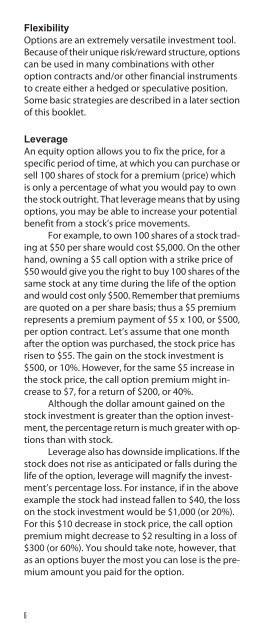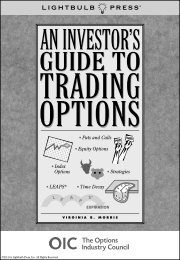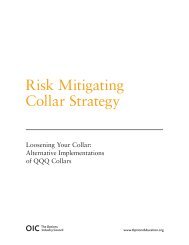Understanding Equity Options - The Options Clearing Corporation
Understanding Equity Options - The Options Clearing Corporation
Understanding Equity Options - The Options Clearing Corporation
- No tags were found...
You also want an ePaper? Increase the reach of your titles
YUMPU automatically turns print PDFs into web optimized ePapers that Google loves.
Flexibility<strong>Options</strong> are an extremely versatile investment tool.Because of their unique risk/reward structure, optionscan be used in many combinations with otheroption contracts and/or other financial instrumentsto create either a hedged or speculative position.Some basic strategies are described in a later sectionof this booklet.LeverageAn equity option allows you to fix the price, for aspecific period of time, at which you can purchase orsell 100 shares of stock for a premium (price) whichis only a percentage of what you would pay to ownthe stock outright. That leverage means that by usingoptions, you may be able to increase your potentialbenefit from a stock’s price movements.For example, to own 100 shares of a stock tradingat $50 per share would cost $5,000. On the otherhand, owning a $5 call option with a strike price of$50 would give you the right to buy 100 shares of thesame stock at any time during the life of the optionand would cost only $500. Remember that premiumsare quoted on a per share basis; thus a $5 premiumrepresents a premium payment of $5 x 100, or $500,per option contract. Let’s assume that one monthafter the option was purchased, the stock price hasrisen to $55. <strong>The</strong> gain on the stock investment is$500, or 10%. However, for the same $5 increase inthe stock price, the call option premium might increaseto $7, for a return of $200, or 40%.Although the dollar amount gained on thestock investment is greater than the option investment,the percentage return is much greater with optionsthan with stock.Leverage also has downside implications. If thestock does not rise as anticipated or falls during thelife of the option, leverage will magnify the investment’spercentage loss. For instance, if in the aboveexample the stock had instead fallen to $40, the losson the stock investment would be $1,000 (or 20%).For this $10 decrease in stock price, the call optionpremium might decrease to $2 resulting in a loss of$300 (or 60%). You should take note, however, thatas an options buyer the most you can lose is the premiumamount you paid for the option.6










